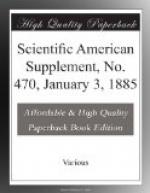is the same, and the separation of the nearer components
impracticable. The object of analysis consisted
in estimating the accompanying impurities of fat,
as, resin, albuminoids, and pigments. The nature
of these substances depends on the mode of extraction
and preservation of the fat, and are subject in the
course of time to alteration. The only reaction
based upon the chemical constitution of fat is produced
by treatment of oleic or linoleic acid with nitrous
acid, which therefore is of some value in the examination
of drying oils. Of general application are the
methods which correspond to the chemical constitution
of fats, and thus determine the relative quantity
of the components; advantage can then be derived from
qualitative reactions, inasmuch as they further affirm
the result of the quantitative test, or dispel any
doubt with regard to the correctness of the result.
The principal methods which comply with these demands
have been carefully studied by Hueble for the purpose
of discovering a process of general application; methods
founded on the determination of density, freezing,
and melting point were compared with those dependent
on the solubility of fatty substances in glacial acetic
acid or a mixture of alcohol and acetic acid; also
the method of Hehner for testing of butter, the determination
of glycerine and oleic acid, and at length the process
of saponification. Nearly all fats contain members
belonging to one of the three series of fatty acids,
e.g., acids of the type of acetic acid (stearic
and palmitic acids); such as are derivatives of acrylic
acid (oleic and erucic acids); and such as are homologues
of tetrolic acid (linoleic acid). It is likely
that the relative quantity of each of these acids
is variable, with regard to the same fat, within definite
limits, and changes with the nature of the fatty substance.
The groups of fatty acids are distinguished by a characteristic
deportment toward halogens; while members of the first
series are indifferent to haloids, those of the second
and third class combine readily, without suffering
substitution, with two respectively four atoms of
a haloid. In view of this behavior the first
series is termed saturated, the second and third that
of unsaturated acids. Addition of halogen to
one of the unsaturated acids yields on subsequent
examination an invariable quantity of the former, representing
two or four atoms, according to one or the other of
unsaturated groups; and as the molecular weights of
fatty acids are unequal, the percentage quantity of
halogen will be found varying with regard to members
belonging to the same series. The amount of iodine
absorbed by some of the fatty acids is illustrated
by the following items:




